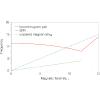当前位置:
X-MOL 学术
›
Phys. Rev. B
›
论文详情
Our official English website, www.x-mol.net, welcomes your feedback! (Note: you will need to create a separate account there.)
Electron spin resonance for the detection of long-range spin nematic order
Physical Review B ( IF 3.7 ) Pub Date : 2018-03-20 00:00:00 , DOI: 10.1103/physrevb.97.104411 Shunsuke C. Furuya , Tsutomu Momoi
Physical Review B ( IF 3.7 ) Pub Date : 2018-03-20 00:00:00 , DOI: 10.1103/physrevb.97.104411 Shunsuke C. Furuya , Tsutomu Momoi

|
Spin nematic phase is a quantum magnetic phase characterized by a quadrupolar order parameter. Since the quadrupole operators are directly coupled to neither the magnetic field nor the neutron, currently, it is an important issue to develop a method for detecting the long-range spin nematic order. In this paper, we propose that electron spin resonance (ESR) measurements enable us to detect the long-range spin nematic order. We show that the frequency of the paramagnetic resonance peak in the ESR spectrum is shifted by the ferroquadrupolar order parameter together with other quantities. The ferroquadrupolar order parameter is extractable from the angular dependence of the frequency shift. In contrast, the antiferroquadrupolar order parameter is usually invisible in the frequency shift. Instead, the long-range antiferroquadrupolar order yields a characteristic resonance peak in the ESR spectrum, which we call a magnon-pair resonance peak. This resonance corresponds to the excitation of the bound magnon pair at the wave vector . Reflecting the condensation of bound magnon pairs, the field dependence of the magnon-pair resonance frequency shows a singular upturn at the saturation field. Moreover, the intensity of the magnon-pair resonance peak shows a characteristic angular dependence and it vanishes when the magnetic field is parallel to one of the axes that diagonalize the weak anisotropic interactions. We confirm these general properties of the magnon-pair resonance peak in the spin nematic phase by studying an bilinear-biquadratic model on the square lattice in the linear flavor-wave approximation. In addition, we argue applications to the frustrated ferromagnets and also the orthogonal dimer spin system , both of which are candidate materials of spin nematics. Our theory for the antiferroquadrupolar ordered phase is consistent with many features of the magnon-pair resonance peak experimentally observed in the low-magnetization regime of .
中文翻译:

电子自旋共振检测远距离自旋向列顺序
自旋向列相是一种以四极阶参数为特征的量子磁相。由于四极子算子不直接耦合到磁场或中子,因此,目前,开发一种检测远距离自旋向列序的方法是重要的问题。在本文中,我们提出电子自旋共振(ESR)测量使我们能够检测远距离自旋向列顺序。我们显示,ESR频谱中顺磁共振峰的频率随四极铁阶参数和其他数量而移动。可以从频移的角度依赖性中提取四极铁阶参数。相反,反铁四极阶参数通常在频移中不可见。反而,远距离的反铁四极阶在ESR谱中产生一个特征性的共振峰,我们称之为磁振对共振峰。该共振对应于在波矢量处对束缚的磁振子对的激发。。反映束缚的磁振子对的凝结,磁振子对共振频率的场相关性在饱和场处显示出一个奇异的上升。此外,磁振对共振峰的强度表现出特征的角度依赖性,并且当磁场平行于使弱各向异性相互作用对角化的轴之一平行时,其消失。我们通过研究一个自旋向列相来确认磁振对共振峰的这些一般性质。线性味波近似中方格上的双线性-双二次模型。此外,我们认为应用到 沮丧的铁磁体以及 正交二聚体自旋系统 ,两者都是自旋向列相的候选材料。我们的反铁四极有序相理论与在低磁化状态下实验观察到的磁振对共振峰的许多特征是一致的。
更新日期:2018-03-20
中文翻译:

电子自旋共振检测远距离自旋向列顺序
自旋向列相是一种以四极阶参数为特征的量子磁相。由于四极子算子不直接耦合到磁场或中子,因此,目前,开发一种检测远距离自旋向列序的方法是重要的问题。在本文中,我们提出电子自旋共振(ESR)测量使我们能够检测远距离自旋向列顺序。我们显示,ESR频谱中顺磁共振峰的频率随四极铁阶参数和其他数量而移动。可以从频移的角度依赖性中提取四极铁阶参数。相反,反铁四极阶参数通常在频移中不可见。反而,远距离的反铁四极阶在ESR谱中产生一个特征性的共振峰,我们称之为磁振对共振峰。该共振对应于在波矢量处对束缚的磁振子对的激发。。反映束缚的磁振子对的凝结,磁振子对共振频率的场相关性在饱和场处显示出一个奇异的上升。此外,磁振对共振峰的强度表现出特征的角度依赖性,并且当磁场平行于使弱各向异性相互作用对角化的轴之一平行时,其消失。我们通过研究一个自旋向列相来确认磁振对共振峰的这些一般性质。线性味波近似中方格上的双线性-双二次模型。此外,我们认为应用到 沮丧的铁磁体以及 正交二聚体自旋系统 ,两者都是自旋向列相的候选材料。我们的反铁四极有序相理论与在低磁化状态下实验观察到的磁振对共振峰的许多特征是一致的。



























 京公网安备 11010802027423号
京公网安备 11010802027423号